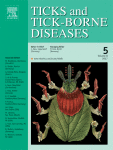Ver ítem
- xmlui.general.dspace_homeCentros Regionales y EEAsCentro Regional Santa FeEEA RafaelaArtículos científicosxmlui.ArtifactBrowser.ItemViewer.trail
- Inicio
- Centros Regionales y EEAs
- Centro Regional Santa Fe
- EEA Rafaela
- Artículos científicos
- Ver ítem
Infection with Ehrlichia canis and Anaplasma platys (Rickettsiales: Anaplasmataceae) in two lineages of Rhipicephalus sanguineus sensu lato (Acari: Ixodidae) from Argentina
Resumen
Natural infection with Ehrlichia canis and Anaplasma platys in ticks belonging to the tropical and temperate lineages of Rhipicephalus sanguineus sensu lato from Argentina was evaluated. Samples were tested for Ehrlichia canis infection by PCR assays using 16S rRNA, dsb and p28 gene, while detection of A. platys was performed with 16S rRNA and groESL gene. The assignment of the ticks to each lineage was corroborated with 16S rDNA sequences. All ticks
[ver mas...]
Natural infection with Ehrlichia canis and Anaplasma platys in ticks belonging to the tropical and temperate lineages of Rhipicephalus sanguineus sensu lato from Argentina was evaluated. Samples were tested for Ehrlichia canis infection by PCR assays using 16S rRNA, dsb and p28 gene, while detection of A. platys was performed with 16S rRNA and groESL gene. The assignment of the ticks to each lineage was corroborated with 16S rDNA sequences. All ticks infected with E. canis and A. platys belonged to the tropical lineage. These results constitute the first record of E. canis infection in R. sanguineus s.l ticks from Argentina. No ticks from the temperate lineage were found to be infected with E. canis, coinciding with previous studies performed in Argentina and Uruguay where E. canis infection was not detected in R. sanguineus s.l from the temperate lineage. Because the presence of the tropical lineage of R. sanguineus s.l has been documented in tropical areas of northern Argentina between 22° and 24° of south latitude, the findings of this work indicate that transmission of E. canis and A. platys to dogs by R. sanguineus s.l probably occurs along this region
[Cerrar]

Autor
Cicuttin, Gabriel L.;
Tarragona, Evelina Luisa;
de Salvo, María Nazarena;
Mangold, Atilio Jose;
Nava, Santiago;
Fuente
Ticks and tick-borne diseases 6 (6) : 724-729. (September 2015)
Fecha
2015-09
ISSN
1877-959X
1877-9603
1877-9603
Formato
pdf
Tipo de documento
artículo
Palabras Claves
Derechos de acceso
Restringido
 Excepto donde se diga explicitamente, este item se publica bajo la siguiente descripción: Creative Commons Attribution-NonCommercial-ShareAlike 2.5 Unported (CC BY-NC-SA 2.5)
Excepto donde se diga explicitamente, este item se publica bajo la siguiente descripción: Creative Commons Attribution-NonCommercial-ShareAlike 2.5 Unported (CC BY-NC-SA 2.5)

